IN THE GARDEN
They may not be the showiest thing on the patio, but these miniature landscapes inevitably take center stage: “It’s about being in Lilliputian land.”
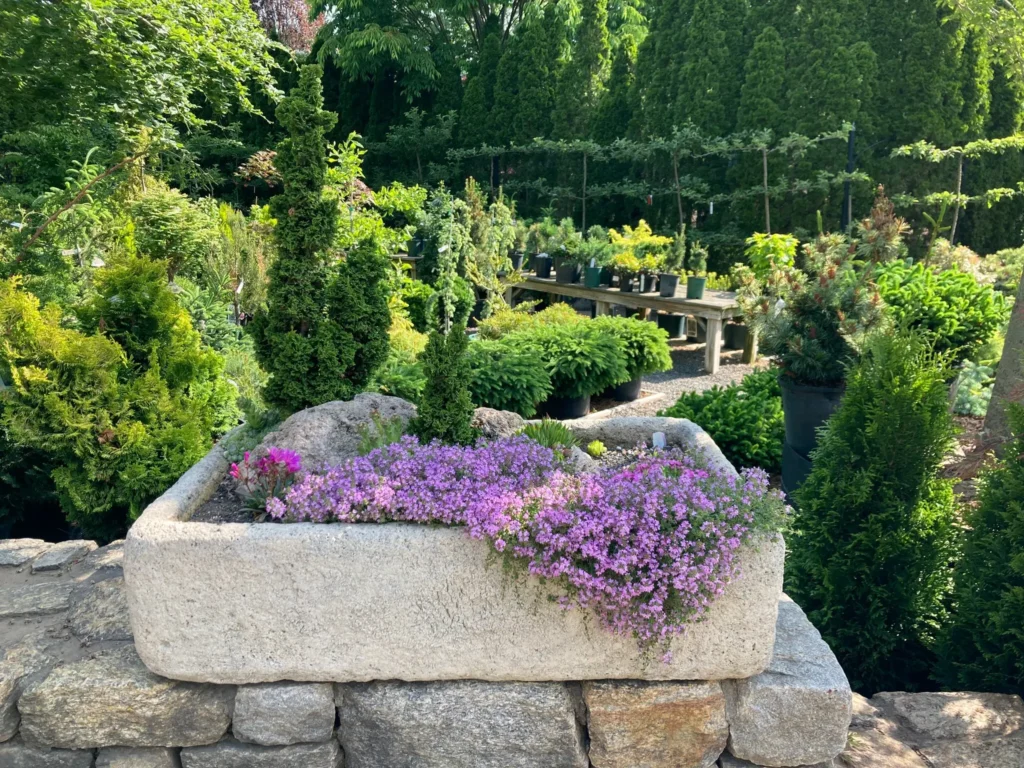
On a wall at Oliver Nurseries, in Fairfield, Conn., the hard edge of a hypertufa trough is softened by creeping thyme, contrasting with the upright element of dwarf conifers.Credit…Lori Chips
By Margaret Roach
July 12, 2023
If you can make space for a miniature rock garden — one of tiny plants growing within the confines of a faux-stone trough — the promise of an outsize payoff awaits.
Inside the walls of a trough you can simulate the conditions required to grow choice species that would sulk in most in-ground beds: certain colorful, sculptural succulents, as well as alpines from the harsh, exposed environment above the tree line.
And then there’s what Lori Chips, of Oliver Nurseries, in Fairfield, Conn., calls “the little theater” factor.
Trough gardens attract an audience, you see.
Have a Gardening Question? Ask Our Expert.
Submit your questions as comments and check back for answers.
Ms. Chips tells the story of a designer and customer she had known for years who had never planted a trough, despite his extensive garden-making experience. He bought a cylindrical one made of hypertufa — a cement-and-peat mixture that simulates the look of stone — and a miniature creeping thyme to put in it. A modest start, to be sure.
On a return visit to the nursery, where Ms. Chips has worked for 27 years, he recounted his trough debut. He had set the vessel on his patio, where there were larger containers of showier plants, but it was the little trough that got the most attention from visitors.
“Every person who walked in would say, ‘What is that?’” he reported. “Because it was featured in a trough.”
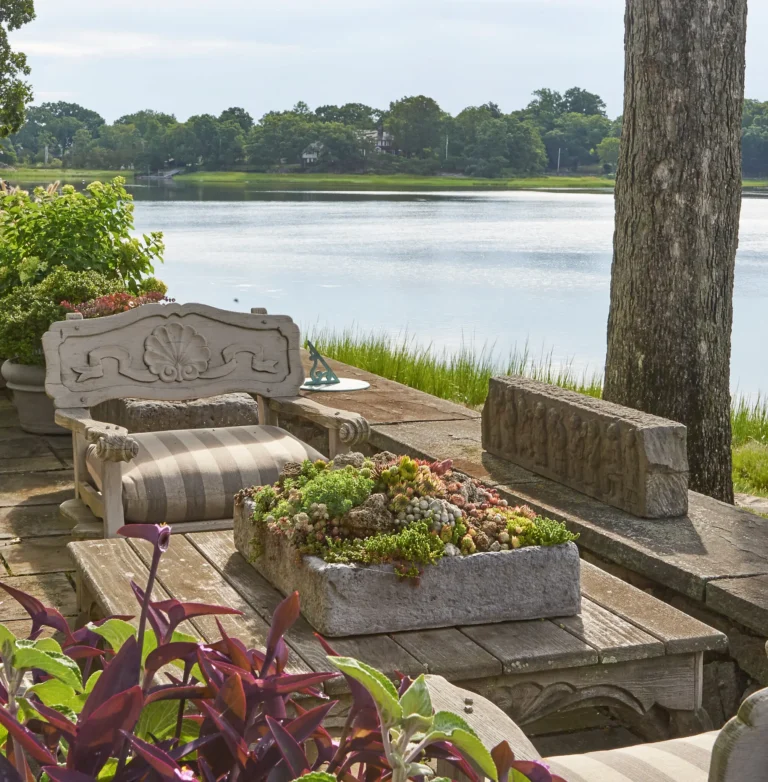
A generous trough of tiny succulents makes a big statement at a private garden in Connecticut.Credit…Jeff McNamara
At Oliver Nurseries, the alpines and plants that favor trough-like conditions are a small part of the vast offerings, as they have been since the nursery opened nearly 60 years ago. These diminutive stars can be seen spilling out of pockets in a 35-foot-long rock retaining wall, in the gravel bed above it and, of course, in troughs and more troughs.
Selling tiny plants may not be the mainstay of the business, “but it’s one cachet cow,” Ms. Chips joked. The nursery, in a bucolic setting that feels like an old garden, attracts a clientele that includes beginning gardeners and connoisseurs who come for the carefully curated selection and the depth of staff expertise.
It’s no surprise that rock-garden plants are an indelible element of the Oliver DNA: Early on, the nursery’s founder, John Oliver, hired Eleanor Spingarn, who is credited with starting the Connecticut chapter of the North American Rock Garden Society. Ms. Spingarn built and planted the rock wall in the 1970s.
The showy dry-laid wall, studded with flowering perennials and succulents of distinctive geometry, was restored and replanted this year, one of various projects tackled by the nursery’s new owners, Jed Duguid and Will Hibbs, who bought the retail and landscaping business last year. The two were longtime employees of the previous owner, Mr. Duguid said, and aim to continue the nursery’s traditions.
“We try to be a plantsman’s nursery,” he said. “And to have some more unique things throughout that would be difficult to find elsewhere.”
Including Ms. Chips, and her infectious love of alpines.
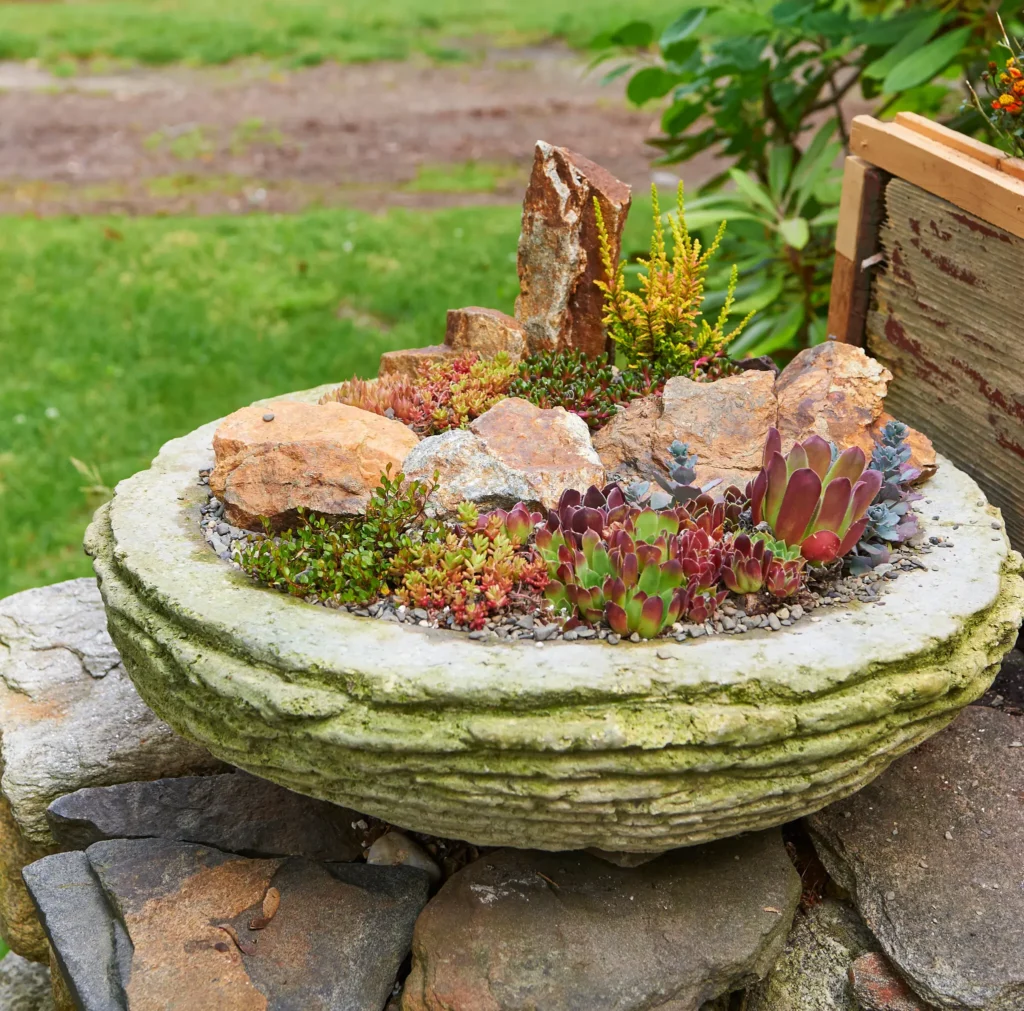
Lori Chips, who has worked at Oliver Nurseries for nearly three decades, chose warm-colored stones to complement the succulents in one of her trough designs — and to evoke the mountains, the natural habitat of many trough plants.Credit…Jeff McNamara
Trough-Garden Basics
Ms. Chips has helped keep the alpine-and-trough tradition going strong at the nursery, and in 2018, her passion yielded a book, “Hypertufa Containers: Creating and Planting an Alpine Trough Garden.” It details every aspect of the process, beginning with how to blend Portland cement, peat moss and fiber mesh (a poly-fiber reinforcing material) to mold the troughs.
Inspired by old stone sinks and farmyard water troughs of another era, these containers have walls that are thicker than those of a basic flower pot. They’re also weather resistant.
But “not weatherproof,” Ms. Chips stressed.
That is particularly true if the troughs are left to winter in a very exposed spot, she added, “like up on a deck, where the cold wind blows beneath them all winter,” increasing freeze-thaw stressors.
Even for those who buy a premade container, some tips in the book — the same advice she gives customers seeking help with container design or care — stand out as essential for success.
First: It may be tempting to turn a shallow concrete birdbath into a trough, but think again. While plants of alpine heritage may look compact aboveground, like tight cushions or mats, their roots need room to run.
Up in the mountains, they cling to “pockets in shifting scree, where gravel and rocks form barely the idea of soil,” Ms. Chips said. “The roots of the plants have evolved to go a yard wide and deep, where they find the coolness and the drainage.”
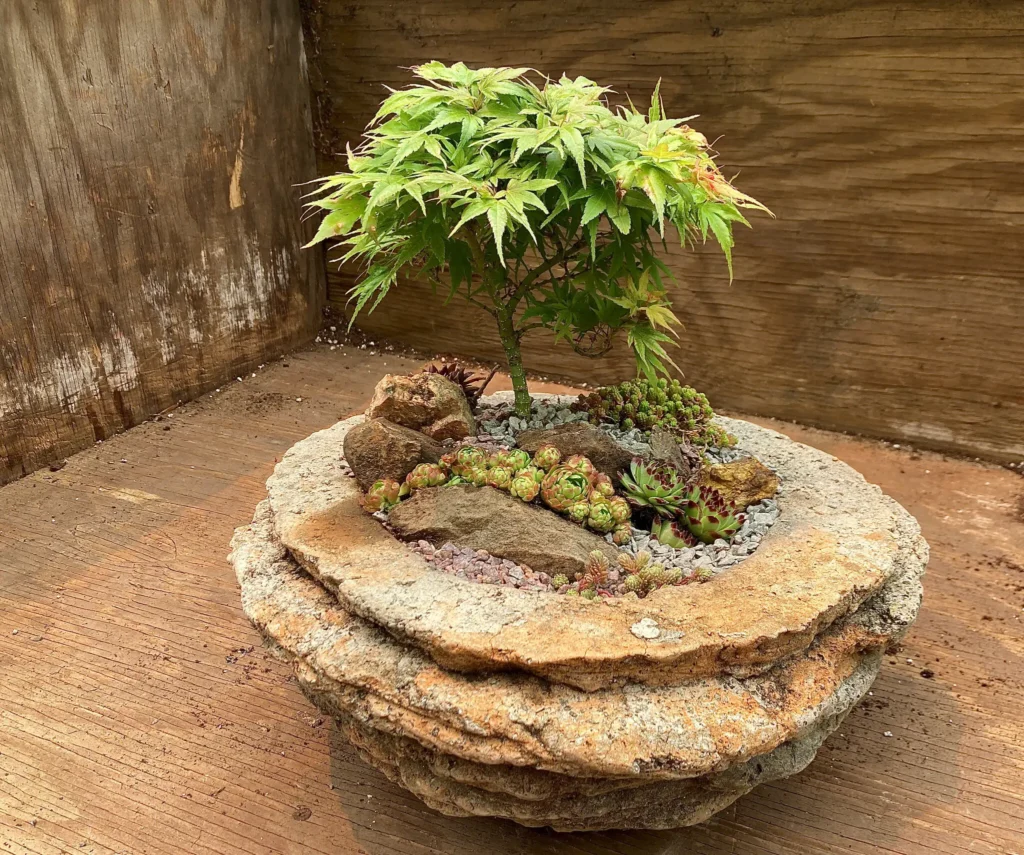
A recently completed trough with a miniature maple tree, on the potting bench at Oliver Nurseries. Planted with the tree, clockwise from back right, are Sedum grisebachii, Sempervivum Sir William Lawrence and Rosularia muratdaghensis.Credit…Lori Chips
A trough that has at least six inches of inside depth is recommended; one with 10 is better. Put a piece of window screening in the bottom to limit drainage-hole clogs.
The planting medium that Ms. Chips uses starts with a peat-based commercial potting soil, like Pro-Mix’s HP or BX formulas. If the brand of available potting soil doesn’t contain perlite, she lightens it with some, so that perlite is as much as a quarter of the blend. Next, she adds quarter-inch-diameter pea gravel (also about a quarter of the total volume of the potting medium she’s mixing up). The gravel has multiple benefits, resulting in fewer plant losses, especially over the winter, because the plants stay put better.
“Freezing and thawing is mitigated, because there’s some stone in there,” Ms. Chips said. “I think the roots get tangled around little pebbles, like an anchor.”
A layer of gravel is applied on top after planting — and not just for aesthetics. “It also helps keep the roots cool,” she said, “and weights the plants down.”
When you’re planting a wall garden, she said, even more gravel goes into the mix — as much as three-quarters gravel to one-quarter purchased weed- and pathogen-free soil.
Customers with existing walls often ask the nursery staff about planting them. The staff’s advice: Free-standing stone walls make better homes for chipmunks than for plants. An unmortared retaining wall, however, is fair game.
Planting during a wall’s construction yields the best results. But here’s a trick to try with an existing wall: Lift a few capstones (preferably those that have settled a bit lower than the rest) to make planting pockets for cascading plants. Line the uncovered spot with some of that soil mix. Then place the plants inside, with their roots gently teased apart and their crowns flush with the wall face. Cover with a bit more mix, then replace the capstone and gently water the area.
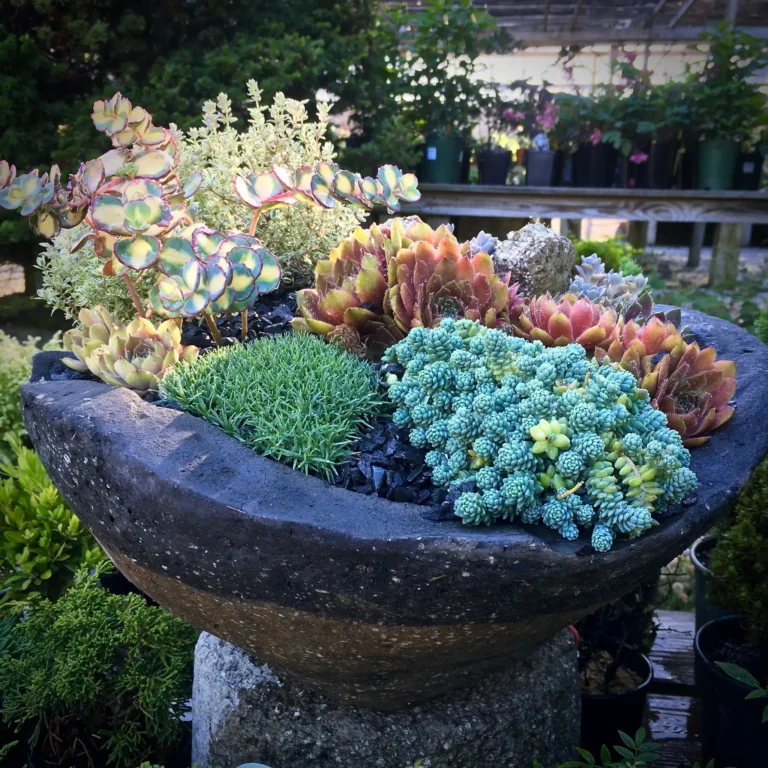
A jumble of flashy succulents joined by a tiny “lawn” of Dianthus, with a cloud of silver thyme behind. Variegated Sedum sieboldii Mediovariegatum, reddish Sempervivum Director Jacobs and nearly aqua-colored Sedum dasyphyllum Major are among the succulents.Credit…Lori Chips
Picking the Plants
The spring bloomers in that wall at Oliver Nurseries include purple-flowered Dalmatian bellflower (Campanula portenschlagiana) and the chain-like golden flowers of Chiastophyllum oppositifolium. Like other perennials that often find their way into troughs — pinks (Dianthus), for instance, and thrift (Armeria) — they are attention grabbers.
But remember: Those blooms don’t last long.
“No alpines are going to bloom all season,” Ms. Chips said. “So you need to fall in love with each plant for its texture and habit.”
Hardiness is another consideration. Any plant growing outdoors year-round in a container — trough or otherwise — should be at least a zone hardier than the local one, because its roots won’t have the earth’s insulation. And even if certain species are technically hardy enough, they may be extra vulnerable to winter wet. That includes most plants with silvery leaves or a fuzzy surface.
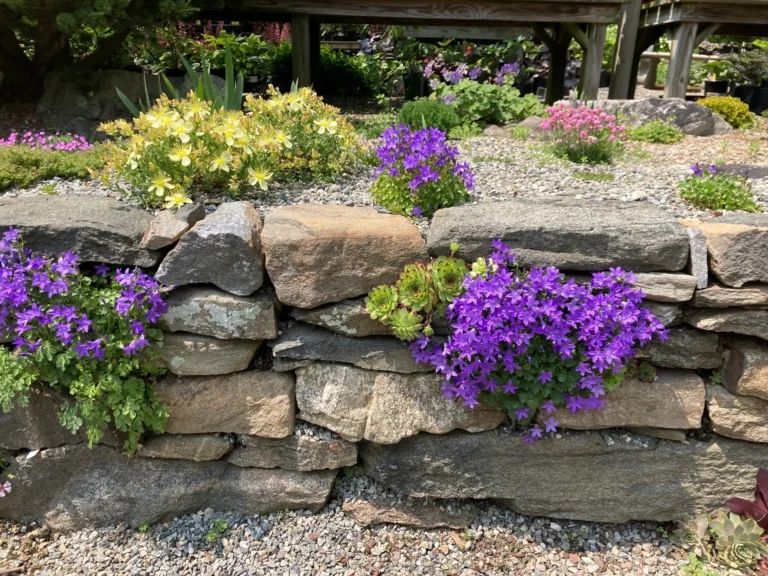
Each spring, purple Dalmatian bellflower (Campanula portenschlagiana), an alpine perennial, stars in the wall garden at Oliver Nurseries, while yellow Hypericum olympicum Citrinum blooms in the gravel above.Credit…Lori Chips
When customers seek design help, Ms. Chips offers this basic advice: “I’ll say, ‘Include a hardy shrub, two other flowering plants, or a drooler or mound.’”
A “drooler”?
Yes, you heard that right: She’s talking about the tiniest thymes, like the variety Elfin, or madwort (Alyssum wulfenianum), and some of the ground-cover sedums. They soften the rim of a trough and spill over, as if liquid onto solid. With the low-growing sedums, seek those that don’t bloom early — or a lot.
As for the “mound,” one possibility is a rosette-shaped succulent, like Sempervivum, Rosularia or Jovibarba. But when you’re shopping for those, steer away from a pot filled by a single rosette. “Don’t buy one pot with one giant artichoke in it, I tell customers — you will lose everything,” she said.
Such succulents are monocarpic, meaning they die after flowering. Instead, buy a pot with various sizes of a particular succulent in it, and encourage them to colonize in your trough by periodically popping some babies off the mother plant and tucking them in nearby.
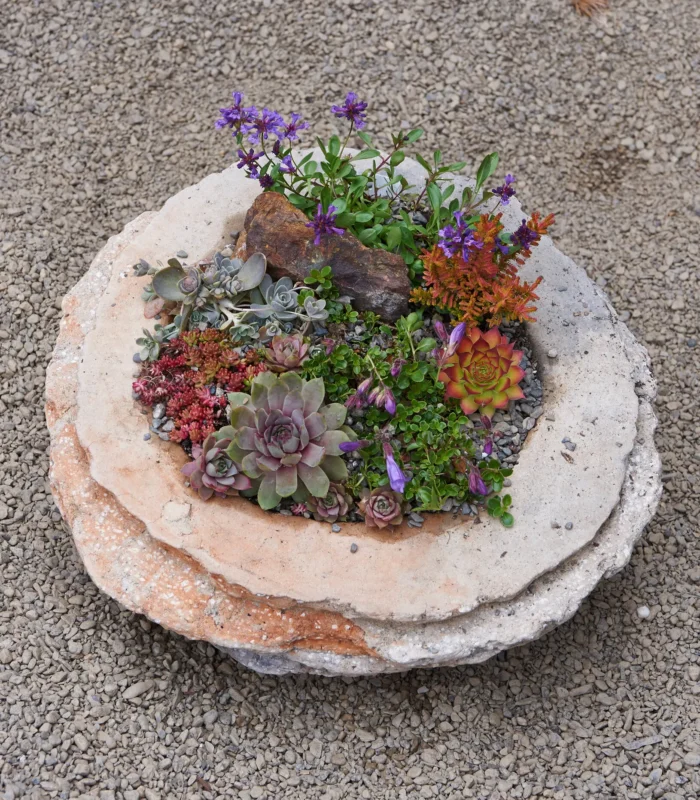
“No alpines are going to bloom all season, so you need to fall in love with each plant for its texture and habit,” Ms. Chips said. When the miniature Penstemon’s tiny purple flowers are finished, a colorful, textural mix of succulents keep this design strong.Credit…Jeff McNamara
Conifers are another element frequently used in troughs and other rock gardens, including gravel gardens and crevice gardens. These diminutive trees add year-round structure.
Ms. Chips recommends varieties that are not just dwarf (slow growing), but true miniatures (meaning they never get very big), like Jean’s Dilly white spruce (Picea glauca). Other favorites: a distinctive mugo pine (Pinus mugo Slowmound) and Chinese juniper (Juniperus chinensis Shimpaku).
Miniature irises are another possibility. They do better in troughs than in the ground, Ms. Chips said. But to her eye, they don’t work well in a trough that includes a conifer, unless it’s a big container. Otherwise, the two will fight for the honor of being the upright, architectural element of the show.
“Having both will throw the aesthetic off,” she said.
The visual goal, she reminded us: “It’s about being in Lilliputian land — about making your trough believable, a miniature landscape.”
Margaret Roach is the creator of the website and podcast A Way to Garden, and a book of the same name.

